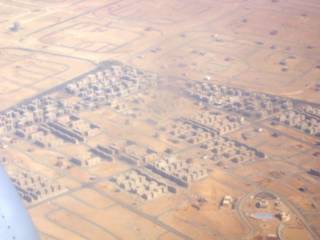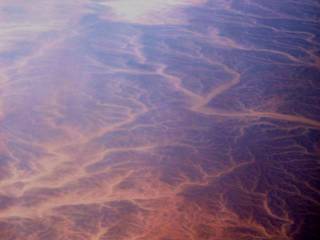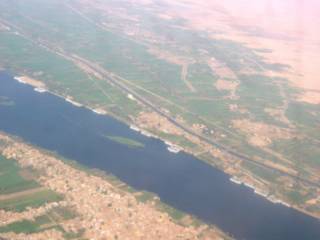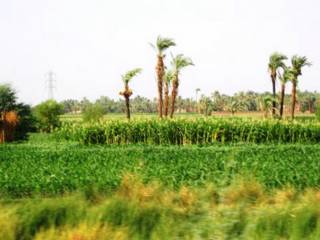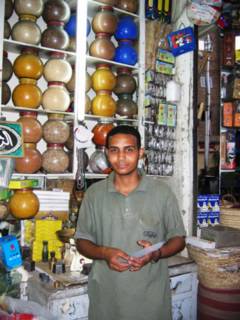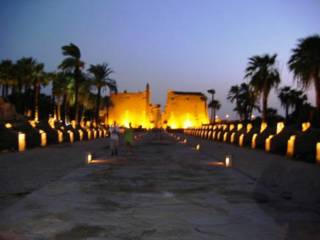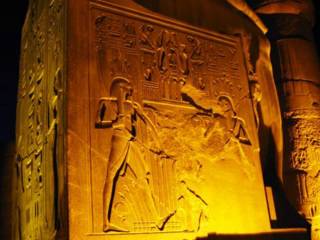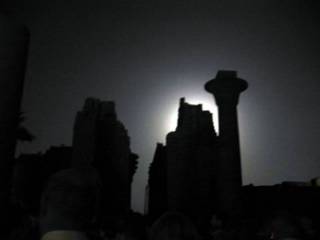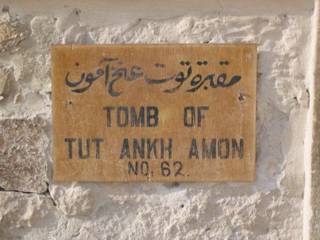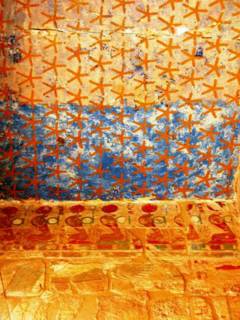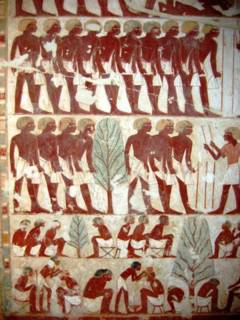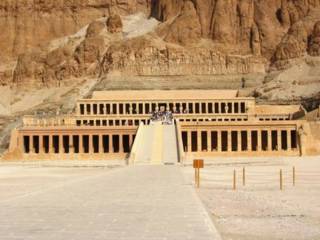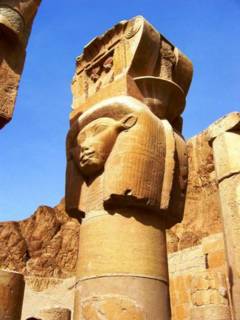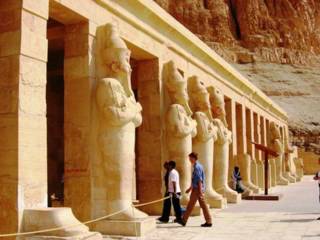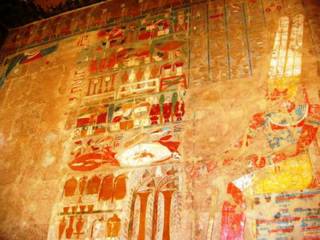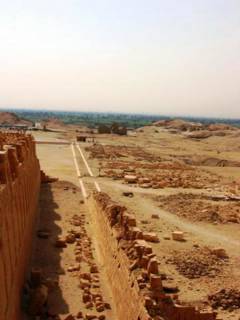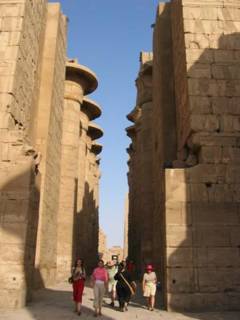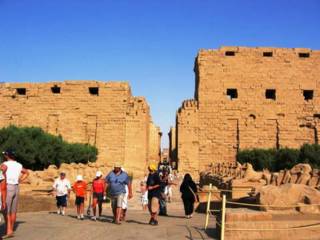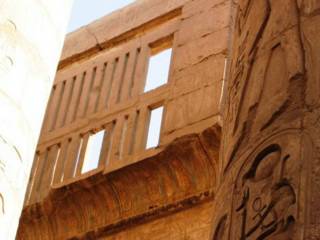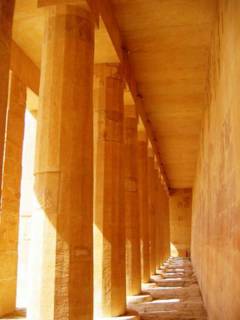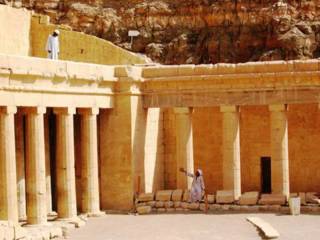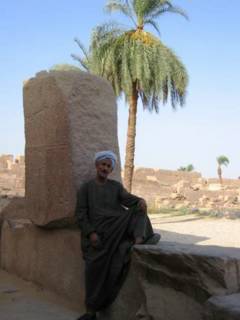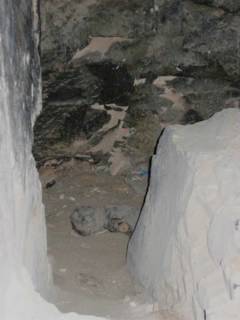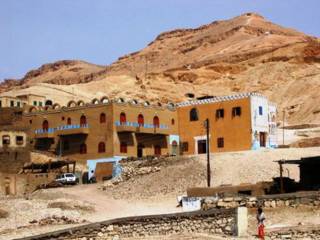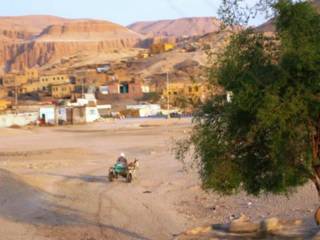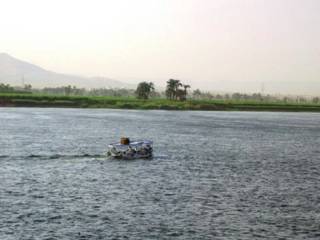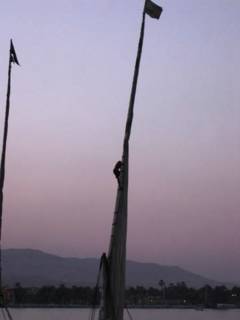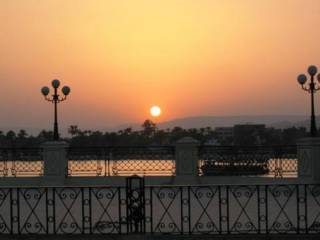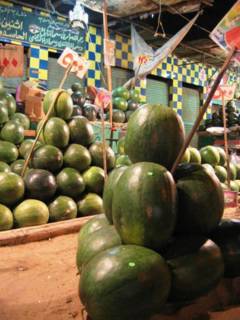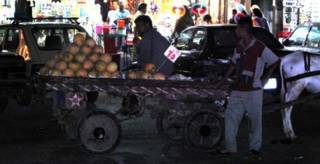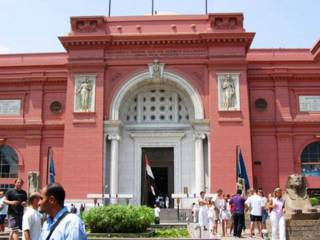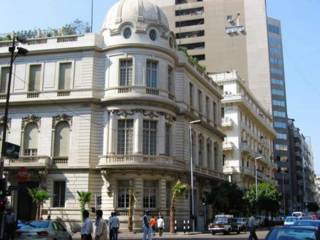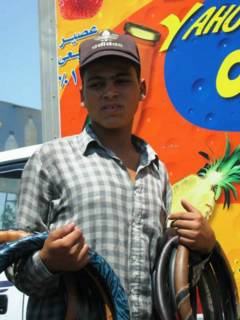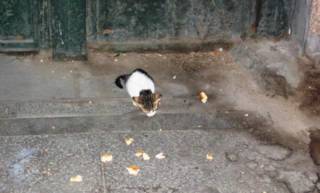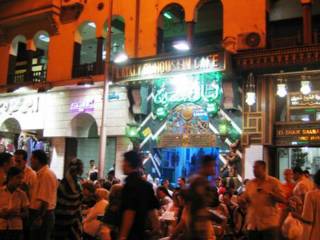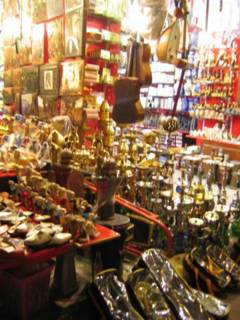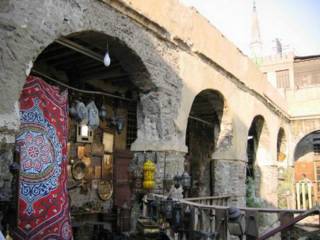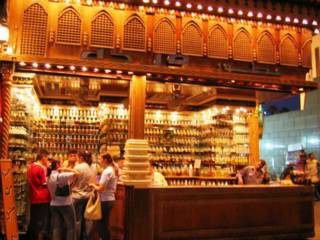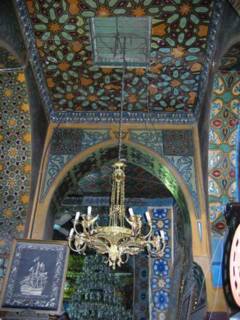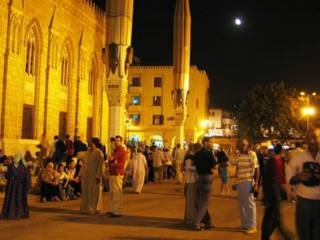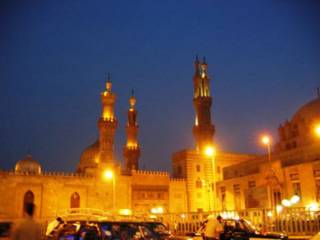Egypt 1: Fuul and Lipton - First Impressions of Cairo
July 29, 2004
The Capital City formerly known as Al-Qahira ("the victorious") during the Fatimid Empire, and subsequently corrupted by foreign tongues into Cairo, is an assault on the senses.
I arrived at 7 am on a Friday. The immigration officer passed my passport through a little hole in the wall of his cubicle, into another cubicle that was blocked on 4 sides by black opaque plexi-glass. "Wait a minute please," he said, and motioned that I should move 5 inches away so the next person behind the yellow line can step up. An official yet anonymous hand handed my passport to me out of Plexi-glass Cube, and I was on my way. That was also the first time I spoke Arabic to an Egyptian: “Shukran, maais salaam.” (Thanks, goodbye.)
It was great to see Neveen again. That was the second time I spoke Arabic to an Egyptian: "Izzeyik, habibi!" (How are you, darling) Neveen's cousin Adel was there to pick me up. The air was dry, with a hint of sandy pollution. With the sun rising behind the airport, we drove off with our lives in Adel's hands.

All In A Day's Work
My first introduction to living norms in Cairo - Friday mornings are quiet, because it's the day off; broad multi-lane highways that lead out to the city center were mostly empty aside for some buses and the occasional passenger vehicle.
"Take a picture, Pat! Cairo buses are not normally empty like this," says Adel. But I did get to see little kids hanging off the back of donkey carts (Arabaya Caru), buses that slow down for passengers on the run without truly stopping, drivers that honk to say hello or to make sure the horn is still working, and lane markings and red lights were just mere suggestions to traffic.
We went past grand mansions that were on tracts of land reserved for the current President, and through a tunnel built to provide him easy access to town. Past where President Sadat was assassinated, opposite where he was buried. Past two statues of Ramses, both with his - um – back to us. One of Egypt's most powerful historic symbols turns his back on the visitors when they arrive, but bids them goodbye to their face - what is the significance of that, I wonder.

President Sadat Was Assasinated Here
Cairo is a modern metropolis, with broad roads and overhead highways criss-crossing the various neighborhoods that have distinct personalities. The urban layout is very reminiscent of Paris, which is no surprise since the Chief Architect of Cairo's city planning, Monsieur Osman, also was key in the planning of Paris.

Downtown Cairo Architecture
One particularly poignant reminder of foreign colonial influences on Cairo was the ubiquitous Lipton sign. The distinctive yellow and red label can be seen hanging off lampposts on main boulevards, adorning the sides of old buildings, plastered on billboards inside new ones, and always appearing in shop windows. One begins to wonder what the mighty British empire would have become if it wasn't for the intrepid trading moguls of the East/West India Company.

Lipton
As we drove past relatively smooth traffic and the heat began to intensify, Neveen mentioned something interesting: "Everything in Cairo is a shadow of what it once was." How apt - grand pharoanic monuments are lost amid bustling city traffic. Ornate Islamic architectural landmarks and modern industrial buildings are covered alike in a thick layer of sand and dirt. You suspect behind closed shutters, the daily lives of Cairo residents are taking shape quietly. As the day heats up, the haze intensifies until around 2 pm, the hottest part of the day, you see a blurred Cairo through a curtain of dust particles. Everything seems muted - as if the rich history and vibrant culture are hidden behind the sands of time and waves of heat, the entire city a mirage on its own.

The Nile in a Haze
A funny image arrived unbidden - someone taking a giant squeegee sponge swipes across the city of Cairo like a huge windshield wiper, so that the domes, minarets, statues and the beautiful Nile will gleam in the sunlight again.

Oct 6 Bridge and Pollution
We drove through some fascinating parts of Cairo, including a scenic turn along an old aqueduct that snakes all around Cairo along its old borders and brought water from the Nile to the top of a hill - quite an engineering marvel.
Cruising on the highway past old Cairo brings a whiff of true spice through the car window. Sayeed Aeesa, which is a part of town that has become famous for cheap clay pottery and infamous for expensive drugs, runs along one side of the aqueduct wall.

Sayeed Aeesa
We got stuck behind a gnarled knot of traffic, all vehicles attempting to disregard the red light at the same time, including a passenger bus, a banged up old Peugeot, a dusty new Renault, a donkey cart and a dozen or so jaywalkers. The dodge-and-run styles of driving and street conditions make me very happy that Adel is driving a jeep with awesome suspension.

Stalled Cairo Traffic
Hunger drove us to one of Adel's favorite spots - a hole-in-the-wall selling Fuul - pronounced exactly the way it's spelled. Fuul is a spiced mixture of fava beans cooked in oil and mashed up, in many ways similar to refried beans in a burrito.

Fuul Man's Son
Apparently this man makes the best fuul in town, and does it for pennies. The owner is in the courtyard in front of his store chatting with the locals, lounging in his chair while smoking a cigarette. His son is behind the counter, efficiently moving from one fuul sandwich to the next as customers line up outside.

Fuul Man and Me
We bought a few felafel and fuul sandwiches, and washed them down with Coca Cola. I was told Coke was the perfect complement for fuul, not for while you're eating, but for how you will be feeling after. Folklore has it, after eating fuul, most people become stupid for a little while and can't walk in a straight line, because the blood from the rest of your body rushes towards your stomach to digest the incredible amount of fava beans you just consumed. So I suppose it is a divine coincidence that we would pronounce fuul, "fool".
We went to Neveen's family's apartment in Ma'adi, a leafy and well-to-do suburb of Cairo, with a fair number of diplomatic and official residences. There was no shortage of front door security guards here. Egyptian lifestyle normally involves a long afternoon sit-in or nap between the hours of 12 pm to 4 pm, after the morning rush - this is a practical matter, as it would be too hot to do much of anything outside. After a big late lunch/early dinner around 4 - 5 pm, life begins again and people will only settle down for supper around 10 or 11 pm, finally calling it a day at around 2-3 am. My kind of schedule. :)
Maadi was a good introduction to normal life in modern Cairo. Driving 10 minutes takes you to the local strip, which has small shops, a cybercafe, McDonalds, Pizza (pronounced "bizza" locally) Hut, Hardees' and Baskin Robbins. A fair number of restaurants that serve real Egyptian food also dot the place. Strangely out of place in Maadi, when very at home in Sayeed Aeesa, is the man that delivers the overflowing basket of home-made aish (flat bread) on the back of a bicycle. On Friday evenings, most people do their weekly shopping - in a local strip mall, or a little further to the City Center mall, which contains everything ranging from Crabtree & Evelyn to a monster Carrefour superstore. I felt like I stepped into the Palisades Parkway Mall, off I-87 in Nyack. This is about as far removed from the pyramids as you could possibly get.

Hardee's and Hejab
So after a dinner of grilled meats of all sorts (kofta, kebab, roast pidgeon), where we established that my new nickname is Battah (which means “duck”), we rolled ourselves back to the apartment and finally I got to sleep after a long long long day. Whether it was jet lag, too much meat or hangover effects from fuul, I don't know. Tomorrow we fly to Luxor, and spend a quick 2 days among the Valleys. Tesbah ala khayr (good night).
Next: Luxor... http://atygerontheloose.blogspot.com/2004/08/egypt-2-luxor-walking-in-pharoahs.html
The Capital City formerly known as Al-Qahira ("the victorious") during the Fatimid Empire, and subsequently corrupted by foreign tongues into Cairo, is an assault on the senses.
I arrived at 7 am on a Friday. The immigration officer passed my passport through a little hole in the wall of his cubicle, into another cubicle that was blocked on 4 sides by black opaque plexi-glass. "Wait a minute please," he said, and motioned that I should move 5 inches away so the next person behind the yellow line can step up. An official yet anonymous hand handed my passport to me out of Plexi-glass Cube, and I was on my way. That was also the first time I spoke Arabic to an Egyptian: “Shukran, maais salaam.” (Thanks, goodbye.)
It was great to see Neveen again. That was the second time I spoke Arabic to an Egyptian: "Izzeyik, habibi!" (How are you, darling) Neveen's cousin Adel was there to pick me up. The air was dry, with a hint of sandy pollution. With the sun rising behind the airport, we drove off with our lives in Adel's hands.

All In A Day's Work
My first introduction to living norms in Cairo - Friday mornings are quiet, because it's the day off; broad multi-lane highways that lead out to the city center were mostly empty aside for some buses and the occasional passenger vehicle.
"Take a picture, Pat! Cairo buses are not normally empty like this," says Adel. But I did get to see little kids hanging off the back of donkey carts (Arabaya Caru), buses that slow down for passengers on the run without truly stopping, drivers that honk to say hello or to make sure the horn is still working, and lane markings and red lights were just mere suggestions to traffic.
We went past grand mansions that were on tracts of land reserved for the current President, and through a tunnel built to provide him easy access to town. Past where President Sadat was assassinated, opposite where he was buried. Past two statues of Ramses, both with his - um – back to us. One of Egypt's most powerful historic symbols turns his back on the visitors when they arrive, but bids them goodbye to their face - what is the significance of that, I wonder.

President Sadat Was Assasinated Here
Cairo is a modern metropolis, with broad roads and overhead highways criss-crossing the various neighborhoods that have distinct personalities. The urban layout is very reminiscent of Paris, which is no surprise since the Chief Architect of Cairo's city planning, Monsieur Osman, also was key in the planning of Paris.

Downtown Cairo Architecture
One particularly poignant reminder of foreign colonial influences on Cairo was the ubiquitous Lipton sign. The distinctive yellow and red label can be seen hanging off lampposts on main boulevards, adorning the sides of old buildings, plastered on billboards inside new ones, and always appearing in shop windows. One begins to wonder what the mighty British empire would have become if it wasn't for the intrepid trading moguls of the East/West India Company.

Lipton
As we drove past relatively smooth traffic and the heat began to intensify, Neveen mentioned something interesting: "Everything in Cairo is a shadow of what it once was." How apt - grand pharoanic monuments are lost amid bustling city traffic. Ornate Islamic architectural landmarks and modern industrial buildings are covered alike in a thick layer of sand and dirt. You suspect behind closed shutters, the daily lives of Cairo residents are taking shape quietly. As the day heats up, the haze intensifies until around 2 pm, the hottest part of the day, you see a blurred Cairo through a curtain of dust particles. Everything seems muted - as if the rich history and vibrant culture are hidden behind the sands of time and waves of heat, the entire city a mirage on its own.

The Nile in a Haze
A funny image arrived unbidden - someone taking a giant squeegee sponge swipes across the city of Cairo like a huge windshield wiper, so that the domes, minarets, statues and the beautiful Nile will gleam in the sunlight again.

Oct 6 Bridge and Pollution
We drove through some fascinating parts of Cairo, including a scenic turn along an old aqueduct that snakes all around Cairo along its old borders and brought water from the Nile to the top of a hill - quite an engineering marvel.
Cruising on the highway past old Cairo brings a whiff of true spice through the car window. Sayeed Aeesa, which is a part of town that has become famous for cheap clay pottery and infamous for expensive drugs, runs along one side of the aqueduct wall.

Sayeed Aeesa
We got stuck behind a gnarled knot of traffic, all vehicles attempting to disregard the red light at the same time, including a passenger bus, a banged up old Peugeot, a dusty new Renault, a donkey cart and a dozen or so jaywalkers. The dodge-and-run styles of driving and street conditions make me very happy that Adel is driving a jeep with awesome suspension.

Stalled Cairo Traffic
Hunger drove us to one of Adel's favorite spots - a hole-in-the-wall selling Fuul - pronounced exactly the way it's spelled. Fuul is a spiced mixture of fava beans cooked in oil and mashed up, in many ways similar to refried beans in a burrito.

Fuul Man's Son
Apparently this man makes the best fuul in town, and does it for pennies. The owner is in the courtyard in front of his store chatting with the locals, lounging in his chair while smoking a cigarette. His son is behind the counter, efficiently moving from one fuul sandwich to the next as customers line up outside.

Fuul Man and Me
We bought a few felafel and fuul sandwiches, and washed them down with Coca Cola. I was told Coke was the perfect complement for fuul, not for while you're eating, but for how you will be feeling after. Folklore has it, after eating fuul, most people become stupid for a little while and can't walk in a straight line, because the blood from the rest of your body rushes towards your stomach to digest the incredible amount of fava beans you just consumed. So I suppose it is a divine coincidence that we would pronounce fuul, "fool".
We went to Neveen's family's apartment in Ma'adi, a leafy and well-to-do suburb of Cairo, with a fair number of diplomatic and official residences. There was no shortage of front door security guards here. Egyptian lifestyle normally involves a long afternoon sit-in or nap between the hours of 12 pm to 4 pm, after the morning rush - this is a practical matter, as it would be too hot to do much of anything outside. After a big late lunch/early dinner around 4 - 5 pm, life begins again and people will only settle down for supper around 10 or 11 pm, finally calling it a day at around 2-3 am. My kind of schedule. :)
Maadi was a good introduction to normal life in modern Cairo. Driving 10 minutes takes you to the local strip, which has small shops, a cybercafe, McDonalds, Pizza (pronounced "bizza" locally) Hut, Hardees' and Baskin Robbins. A fair number of restaurants that serve real Egyptian food also dot the place. Strangely out of place in Maadi, when very at home in Sayeed Aeesa, is the man that delivers the overflowing basket of home-made aish (flat bread) on the back of a bicycle. On Friday evenings, most people do their weekly shopping - in a local strip mall, or a little further to the City Center mall, which contains everything ranging from Crabtree & Evelyn to a monster Carrefour superstore. I felt like I stepped into the Palisades Parkway Mall, off I-87 in Nyack. This is about as far removed from the pyramids as you could possibly get.

Hardee's and Hejab
So after a dinner of grilled meats of all sorts (kofta, kebab, roast pidgeon), where we established that my new nickname is Battah (which means “duck”), we rolled ourselves back to the apartment and finally I got to sleep after a long long long day. Whether it was jet lag, too much meat or hangover effects from fuul, I don't know. Tomorrow we fly to Luxor, and spend a quick 2 days among the Valleys. Tesbah ala khayr (good night).
Next: Luxor... http://atygerontheloose.blogspot.com/2004/08/egypt-2-luxor-walking-in-pharoahs.html
